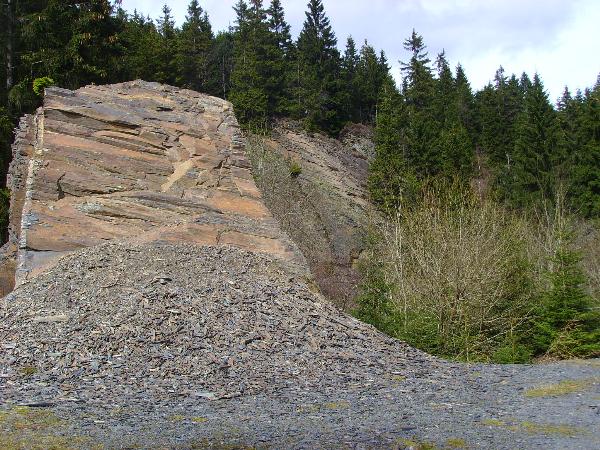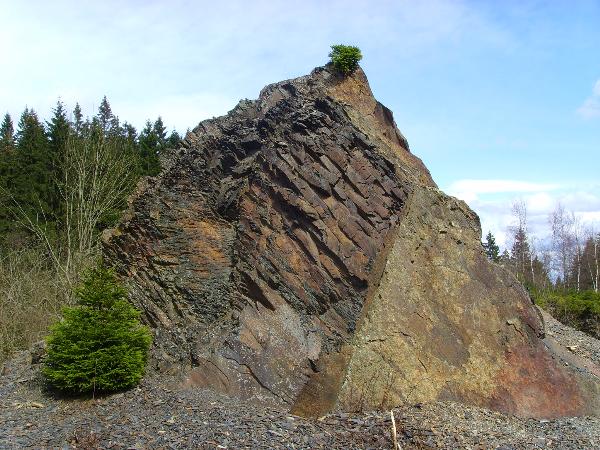Brand EarthCache
-
Difficulty:
-

-
Terrain:
-

Size:  (other)
(other)
Please note Use of geocaching.com services is subject to the terms and conditions
in our disclaimer.
Der Steinbruch am Brand befindet sich ungefähr 2 km westlich der Ortschaft Spechtsbrunn.
Der anstehende Tonschiefer gehört in die stratigraphische Einheit des Griffelschiefers / Ordovizium. Er enthält kaum Quarz und die röhrenartigen Strukturen gefüllt mit Pyrit und andere Lebensspuren weisen auf biologische Aktivität im noch unverfestigtem pelagischen Sediment hin.
Beim Abbau wurden ca. 100 Trilobitenfunde gemacht. Trilobiten sind eine ausgestorbene Klasse meeresbewohnender Gliederfüßer.
Im Steinbruch treten deutlich mehrere Schieferungsrichtungen hervor. Wegen der speziellen Schieferung und des geringen Quarzgehaltes wurde dieser Tonschiefer zur Griffelherstellung abgebaut.
Das Gestein hat einen relativ hohen Eisenanteil, auf den sich auch die Farbe zurückführen lässt. Durch eine niedrige Metamorphose (Grünschiefer-Fazies) wurden Tonminerale zu Sericit und einem eisenreichen Chlorit umgewandelt. Daraus lassen sich eine Temperatur von ca. 290 – 300°C und eine Versenkungstiefe des Gesteins von ca. 15km ableiten.
Um diesen Earthcache zu loggen, schickt mir per Email / Messenger die Antworten auf folgende Fragen. Ein Bild von euch und eurem GPS mit dem freistehenden Schieferblock im Hintergrund wäre natürlich klasse!
1. Wieviel Prozent des abgebauten Materials eignete sich zur Griffelherstellung?
2. Beschreibe Farbe und Beschaffenheit des losen Schiefermaterials vor Ort!
3. Mache von dir und / oder von deinem GPS ein Foto vor Ort und füge es deinem Log bei!


About 2 km to the west of the village Spechtsbrunn you can find the stone quarry Brand.
The upcoming argillaceous shale belongs in the stratigraphic unity of the stylus slate / ordovicican.
It hardly contains quartz and the tube-like structures filled with pyrite and other marks of life point to biological activity in the still unhardened pelagic sediment.
During the working approx. 100 tilobites were found. Trilobites are an extinct class of sea-inhabiting arthropoda.
In the stone quarry several developments of the slates come out clearly. Because of the special character of the slate and the low amount of quartz this argillaceous shale was exploited for the stylus production.
The stone has a relatively high amount of iron on which also the colour can be led back. Clay minerals were converted by a low metamorphosis (green slate - facies) to sericit and an iron-rich chlorite. From it can be derived a temperature of approx. 290 ndash; 300°C and a sinking depth of the rock of approx. 15 m.
To log this Earthcache, email / Messenger me the answers to the following questions. A picture of yourself with your GPS whith the freestanding slate block in the Background would be great!
1. How much percent of the worked material was suited to the stylus production?
2. Describe the colour and the structure of the loose slate material!
3. Make a photo of yourself and / or your GPS on-site and attach it to your log!
Additional Hints
(No hints available.)